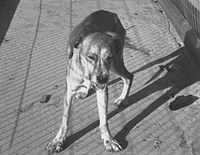
Photo from wikipedia
To investigate seroprevalence of anti‐Leptospira antibodies in equines and associated workers in Uruguay, 891 equine and 150 human sera were drawn; 212 equine urine samples were also taken for culture.… Click to show full abstract
To investigate seroprevalence of anti‐Leptospira antibodies in equines and associated workers in Uruguay, 891 equine and 150 human sera were drawn; 212 equine urine samples were also taken for culture. Environmental conditions and equine raising or managing practices were recorded in all 72 visited establishments; epidemiological information was obtained from each worker. Microscopic agglutination technique (MAT) was performed with 10 Leptospira strains for equines and 18 for human sera, that were also studied with IgM indirect immunofluorescence (IgM‐IIF). Equine titres ≥100 were considered positive, and human sera titres ≥200 suggested probable recent or past infection. Urines were cultured in Ellinghausen–McCullough–Johnson–Harris (EMJH) media; local identification of one obtained isolate with lipL32 PCR, Multiple Locus Variable number tandem repeat Analysis and partial rrs gene sequencing, were completed at Institut Pasteur, Paris. Estimated reactivity was 61.3% for equines, which was higher than the studied bovine national levels (21%) and mainly observed with Icterohaemorrhagiae serogroup (40.3%), Sejroe, Canicola, Pomona or Ballum. Aged animals from slaughterhouses and cattle farms were the most frequently positive. Multiple regression analysis confirmed a significant association between seropositivity and equine age. Only one positive culture could be fully studied, and confirmed to be Leptospira interrogans serogroup Canicola; it was added to the MAT antigen panel and revealed fairly frequent reaction with equine and human sera. Three workers (2%) showed titres = 200 with Icterohaemorrhagiae or Canicola serogroups, without recent clinical manifestations. Their attended equines reacted with the same serogroups, suggesting common source infections or infection transmitted by equines. Three other humans yielded titres = 100, and none of the 150 showed an IgM‐IIF‐positive result. Equines seem not to be an important origin of regional human leptospirosis, except perhaps during acute animal infection. More culture work is required to study intensity and lapses of leptospiruria, as well as to further identify circulating strains.
Journal Title: Zoonoses and Public Health
Year Published: 2022
Link to full text (if available)
Share on Social Media: Sign Up to like & get
recommendations!